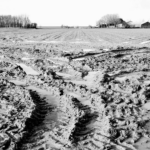The Netherlands has many simultaneous goals. We want to transition to solar and wind energy, to make our agriculture sustainable, to capture more freshwater, to create more nature areas, and also to cut the climate impact significantly. Can you do all that at once?
Today I’m sitting at a gaming table to find out. I’m playing the game SIM4NEXUS, developed in a European project coordinated by Wageningen Economic Research. I see four blocks on my screen. Top left are the Netherlands’ scores for water, energy, land, food and climate in 2020. This shows that we have only achieved some of our objectives in these areas. Bottom right are about 40 policy cards. We can apply these and then the game will calculate what effects they will have over every five-year period from 2025 to 2050. Each card also costs money and time.
The game exposes links between the different policy objectives. ‘To achieve the climate goals, you can close a few coal-fired power stations in this game,’ explain the makers, Vincent Linderhof and Nico Polman at WUR. ‘But the demand for energy remains, so then you have to convert the coal-fired power stations into biomass installations, and import biomass. Those imports reduce the climate gains. But you can cancel that out again with the energy-saving card.’
Decisions, decisions…
We are going to play the game, the first time without policy cards. Then we’ll see how the Netherlands scores in the coming years if there is no change of policy. With regard to water, nitrogen and phosphate emissions from agriculture will go down until 2050, but not enough. In terms of food, we’ll get a bigger proportion of our protein from plants, and we’ll eat less meat, but again, this transition won’t meet the targets. And the push to meet climate goals (a 95 per cent reduction in emissions) will get stuck at less than 30 per cent. ‘But this scenario doesn’t include the Paris climate agreement,’ explains Linderhof.
That is why we are going to introduce a few climate measures in the second game. We will provide extra incentives for introducing wind energy and solar panels, we shall raise the water level in areas with peaty soils, we shall stimulate the transition from meat to a plant-based diet, and we shall invest in CO2 storage. With these policy cards, we prompt SIM4NEXUS to start calculating again. The final conclusion: by 2040 we will have achieved over 30 per cent of our climate goals, a few per cent more than we would with no change of policy. ‘This is nowhere near enough for achieving our climate goals,’ concludes co-developer Floor Brouwer of WUR. Introducing these climate measures also brings unexpected disadvantages with it. The investment in renewable energy sources did not go hand in hand with a decision in favour of additional nature and more extensive agriculture. ‘Here there are pros and cons in terms of biomass,’ says Marian Witmer of the Netherlands Environmental Assessment Agency, one of the partners in SIM4NEXUS. ‘If you use all the biomass from forests to meet your climate goals, you are left with less forest for other purposes. If you give precedence to forest and biodiversity for ecological reasons, you have less biomass at your disposal for achieving climate goals.’
Ecology cards
We are going to test this interim conclusion in a third round, in which we mainly use ecology cards. We are going to save energy, install solar panels on houses, eat vegetarian more often, reduce the livestock herd, invest in wet peat areas and improve the quality of the soil. To our surprise, the climate score goes up to 40 per cent, higher than in the previous game with climate cards. Why is that? This time we also used policy cards related to food. The reduced livestock herd and better soil management are reflected in better nature and climate scores. And so this game exposes interactions between the effects of our food, water, energy and climate policies. When those effects are modelled and calculated, they are reflected in the integral scores of the game.
In the third round of the game we mostly use ecology cards
By this stage of the game, you start to wonder: what are the connections between soil quality, the livestock herd, the wind turbines and greenhouse gas emissions, according to the creators of the game? You would like to take a look at the inner workings of SIM4NEXUS. And you can. On request, you can open flow charts that show the impact of the different policy cards on the outcome.
The biomass catch
At the end of the game, we still don’t know how the Netherlands can achieve its climate and energy goals by 2050. ‘The game opens up discussion,’ says Thomas Mattijssen of WUR. ‘Which policy measures achieve something, do they have any unintended effects, which combination of measures seems to be effective for achieving several goals? Ministries, provinces and water boards can discuss these questions. You can make choices, which lead to further choices, and you can identify the consequences of those choices using this game.’
There is a catch, though. The role of biomass in the transition to a biobased economy is ambiguous. If the Netherlands wants to increase the proportion of renewable energy sources from 9 per cent to 90 per cent by 2050, it will need biomass. But converting wood, manure, organic waste and waste water into energy is anything but sustainable. That kind of detailed knowledge, which is still subject to different interpretations, is part of the integral nexus score in this game.

 Photo: SIM4NEXUS/Alfred Heikamp
Photo: SIM4NEXUS/Alfred Heikamp 

